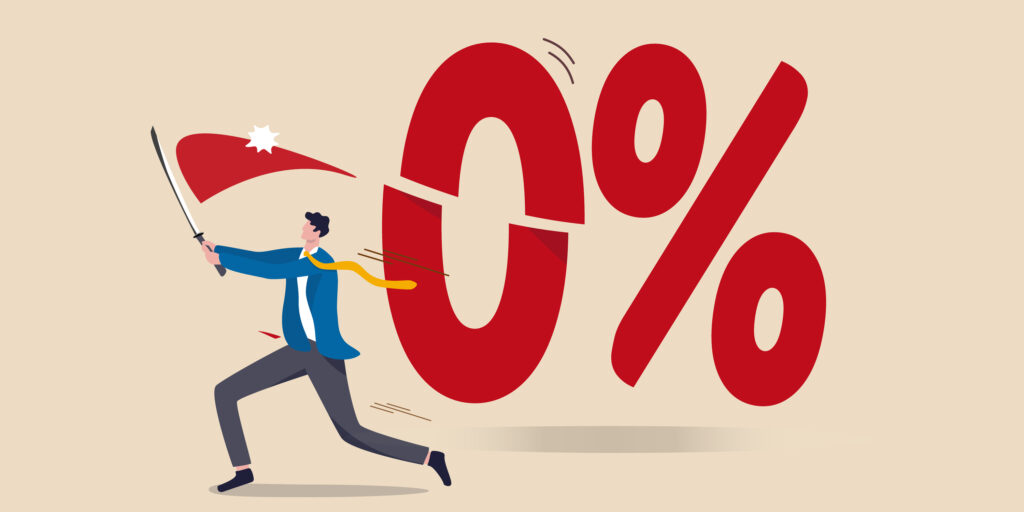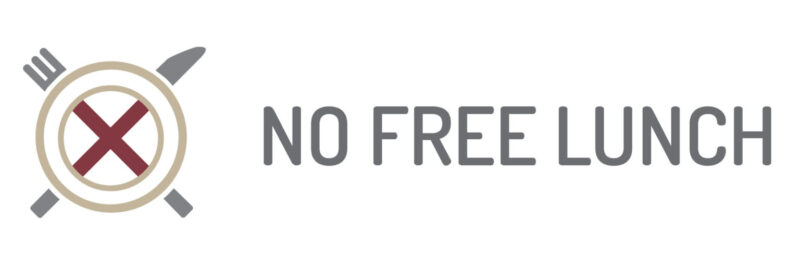
Would you be happy paying a bank for the privilege of depositing funds with them? Despite the paradoxical logic, negative interest rates are a thing. Find out why.
The term negative interest rate sounds like a contradiction in terms. Interest is what you gain for giving a bank liquidity, which the bank then loans out to someone else, pocketing the difference. Why would anyone pay to deposit funds with a bank?
It turns the concept of tinstaafl inside out. Depositors get nothing for something, the inverse of a free lunch.
In a backwards sort of way, this actually suggests that the lender is getting a free lunch, as they are providing no service – offering no return of capital – yet are charging a fee in the form of negative interest.
The logic of negative interest
In the investment banking world, there are a number of reasons why taking a negative interest rate is a rational decision, but it only makes sense when you look at the option as part of complicated strategies with many moving parts. It doesn’t apply to paying a bank to look after your nest egg.
Negative interest rates can be:
- a hedge against deflation
- part of a sophisticated currency hedging strategy
- to exploit capital gains
- as part of portfolio diversification.
You can read more here about the reasons behind accepting negative interest rates.
Where there seems to be no logic for accepting negative interest is in the case of retail investors, who intend to do nothing but deposit their money and accept their passive interest.
Amidst the economic impact of the COVID-19 pandemic, negative interest on retail savings accounts became a reality
This unconventional policy is typically implemented by central banks to encourage lending and stimulate economic activity by disincentivizing hoarding of cash or keeping funds in bank accounts.
- European Central Bank (ECB) Policy: The ECB set negative interest rates for deposits held by commercial banks. In some cases, this led to retail banks passing on the negative rates to corporate and institutional depositors or large account holders.
- Swiss Banks: In Switzerland, some retail banks applied negative interest rates on large deposits held by corporate and institutional clients. This was primarily influenced by the Swiss National Bank’s negative interest rate policy.
- Denmark & Sweden: Banks in Denmark and Sweden implemented negative interest rates in limited cases, particularly for large corporate deposits. This was done in response to central bank policies aimed at stimulating lending and combating deflationary pressures.
- Japan – As of October 2023, the Bank of Japan maintains a negative interest rate of -0.1%, the only central bank with a negative reference rate. Japan has unique structural economic problems, such as an ageing population and sluggish growth.
Accepting passive loss on your deposits seems absurd, especially on top of bank fees, but it seems that the banks have their customers over a barrel. What are the alternatives?
Switching Bank
We all know how much of a ballache switching banks is, so you have to choose the lesser of two evils. Switching banks will only make sense if there is real variation in lending rates, which doesn’t tend to be the case as rates broadly align.
Self Custody
If you don’t want the bank charging you passive interest on your savings, you could simply stuff your cash anonymously under the mattress and assume the huge security risk that entails.
You could buy a safe, but that involves a cost and still isn’t completely secure.
In both cases, you lose the convenience of using banking facilities, for which you were already paying through account fees and the implied charges of using a debit/credit card.
Is crypto the way out?
It really starts to feel that in a negative interest rate environment, fiat savers could be completely snookered, especially if you want liquid funds.
The absurdity of negative interest rates was highlighted as a sign that the fiat ship was sinking, and crypto offered a lifeboat.
Not only has crypto been touted as a superior store of value, but it is also offer alternative banking solutions, collectively known as DeFi. Passive interest rates the likes of which millennials and Gen-Z had never experienced; crypto-denominated debit cards, cash-back on transactions in crypto, all with no barriers to entry.
Crypto APR – too good to be true
During the COVID era of almost limitless money printing, many investors were tempted by crazy APR rates available within crypto without stopping to ask how these returns were possible.
The algorithmic stablecoin Terra (USD) offered 20% APR if locked in the Anchor protocol. For a while, Terra worked perfectly, algorithmically adjusted against another cryptocurrency called Luna, which was backed by…well, nothing.
That $60bn house of cards came tumbling down in May 2022, and the centralised crypto banking options, known as Cefi – centralised finance – fared no better.
Where Defi is driven purely by code, with nothing required but a Meta Mask wallet and tolerance for high transaction costs, Cefi blends the yield benefits of crypto with traditional business structures. In other words, customer support and KYC.
But rather than providing a more regulated way of offering a return on crypto, CeFi was a black box within which unsustainable Ponzi-style logic was fuelling high interest rates.
As crypto experienced its own version of the 2008 Financial Crisis, CeFi providers fell like dominos, leaving huge numbers of investors helpless as lawyers became the only winners of complex Chapter 11 bankruptcy processes.
Negative interest rates, demurrage & CBDCs
Having turned negative in some places, interest rates have, over the last year, accelerated in the opposite direction, returning investors to more familiar territory. But that doesn’t mean we’ve seen the last of negative interest.
For economist Kate Raworth, paying to park your money is one way to build a more equal and sustainable economy. Raworth’s idea is based on currency-bearing demurrage, originally developed by a German Argentinian economist called Silvio Gesell.
In his 1906 book The Natural Economic Order, Gesell proposed money that holders would pay a fee through stamps to keep it in date and redeemable. This would put money on par with other perishable goods, decaying like natural commodities and breaking the quality of durability that Aristotle proposed as one of the five key attributes that make money useful.
Germany and Austria experimented with demurrage currency between the wars in an attempt to rebuild their economies and tame hyperinflation.
Raworth sees our focus on accumulating money as a cause of global economic inequality and environmental degradation and proposes demurrage via electronic currency in her book ‘Doughnut Economics: Seven Ways to Think Like a 21st-Century Economist‘.
Raworth’s highly acclaimed book was written in 2017, a little before the development of Central Bank Digital Currencies (CBDCs), which are now being trialled by 130 central banks, including the potential feature of money with an expiry date.
Paradoxically, those within the crypto community see CBDCs as the antithesis of circular economics and rather a tool for surveillance capitalism, so it would be interesting to see whether they represent the new form of money that Raworth imagined.
Like climate, the global economy is likely to become far more unpredictable, with greater volatility and shorter cycles. We likely haven’t seen the last of negative interest rates, so maybe keep some space under that mattress.
Currency demurrage is the idea of charging a fee to hold money as a means of promoting its exchange instead of hoarding. It is an idea first proposed by German-Argentinian economist Silvio Gesell in 1906 in the book The Natural Economic Order.
As of October 2023, the Bank of Japan, with an interest rate of -0.1%, is the only central bank maintaining a negative interest rate policy.
No Free Lunch
There is no such thing as a free lunch, but if you’re hungry to find out why, we’re here to help.
You can learn the meaning and origin of the no free lunch concept, as well as the broader philosophy behind the idea that nothing can ever be regarded as free.
We look at our relationship with money and truth, examining all of the supposed shortcuts, life hacks and get-rich-quick schemes.
